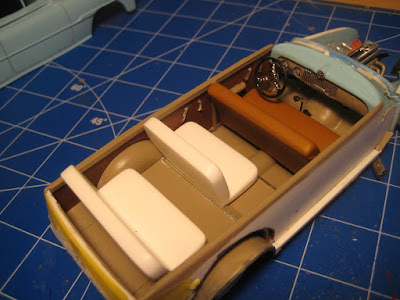The first step is a bath in acetone (a.k.a. nail polish remover). Tip: get the unscented one. The 'dirty' acetone can be poured back in the container for your next project. Note nitrile gloves are eaten away by acetone, which is a pretty strong solvent; use tweezers and eye protection and a way of ensuring your bits don't go down the drain. Also note that acetone dissolves CA glue (superglue), so don't use it if you've already started building.

Second is to identify all the little gubbinses and where they go. Unlike a styrene kit, most bits are not on a sprue, and are not identified in any way. The instruction sheet in this particular case is a little slim, with some bits not well illustrated, and identified only by a code number. For example, M18 mounts to the lower timing chain cover on the left side, and is, I think, a fuel pump; the picture is not clear and I still haven't found anything in the kit that looks like it might go there. It is really important not to assume that some little gubbins is the fuel pump and glue it in, only to discover later it was, in fact, the brake master cylinder. And watch for duplicates that may or may not be mirror images; the two magnetos on this car are mirror images, but not exact mirrors (one has the tachometer drive - can you spot it in the photo? It's obvious once pointed out.) Photos of 1:1 cars from the InterWeb, especially period photos, can be valuable.

Third is to clean up the flash which is very fine but which will show up once painted if you don't scrape it off. Some bits are long and thin, and can easily be bent, so this requires patience and care.

Fourth is test fitting everything. Dowels will not be clean but will have shoulders that need to be filed down so the part can seat firmly; the matching socket is probably just a dimple which will need to be drilled out, and the flange with the socket may well be slightly domed. Drill sizes will be metric, with 0.4 mm (#78), 0.5 mm (#76) and 1.0 mm (#61 or #60) common. Plug wires supplied are very fine at about 0.011" (0.3 mm); while this is smaller than a #80 bit, the risk of breaking the #80 bit off in the hole is significant, so I went for 0.016" (#78).

Then and only then do you go for primer. Here I assembled everything that was to be painted aluminum prior to painting to avoid having to scrape paint off glue surfaces.

So far so good. Stay tuned!
Oh, and the difference between the magnetos? In the photo below, the one at upper right (right side of the car) has a longer shaft pointing towards the bell housing than the one at lower left.

PS note the flywheel which will be completely hidden from view once assembled. Other MFH kits have actually included clutch disc, pressure plate and throwout bearing. in 1/43 scale. Now that's detail.






































